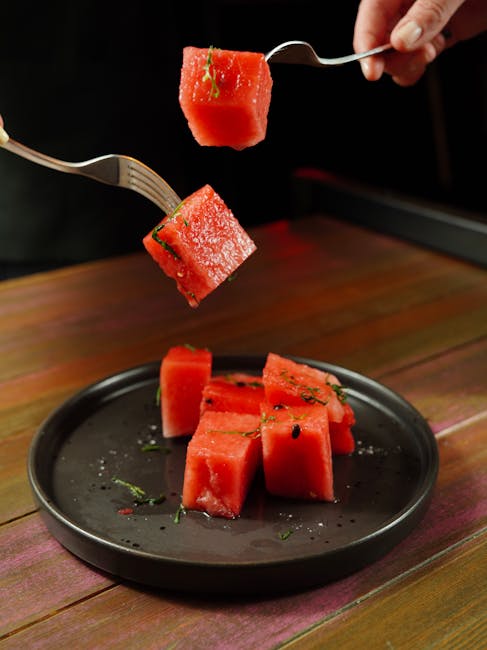Watermelon, the juicy, vibrant fruit that’s synonymous with summer, has a rich history stretching back millennia. Its origins trace back to Northeast Africa, possibly in the Kalahari Desert region, where evidence suggests cultivation began over 4,000 years ago. Ancient Egyptians held the fruit in high regard, depicting it in hieroglyphics and even burying it with their pharaohs, believing it offered sustenance in the afterlife. These early watermelons differed significantly from the sweet, seedless varieties we enjoy today; they were often smaller, harder, and contained numerous seeds.
The watermelon’s journey from Africa spread across the globe, aided by trade routes and exploration. It arrived in Europe during the medieval period and later made its way to Asia and the Americas. Today, China is the world’s leading producer of watermelons, accounting for over 70% of global production, followed by Turkey and Iran. The sheer volume of watermelons grown globally is staggering; the sheer scale of cultivation reflects its enduring popularity as a refreshing and nutritious fruit. Its adaptability to diverse climates has contributed to its widespread cultivation, making it a staple in many cultures worldwide.
Beyond its simple enjoyment as a fruit, watermelon holds significant cultural meaning in various societies. In some parts of Africa, it remains a vital part of traditional ceremonies and celebrations. In many cultures, watermelon is a symbol of summer, warmth, and abundance. Its vibrant red flesh is often associated with prosperity and good luck. The refreshing juice extracted from the watermelon has also become a beloved beverage, its simple yet satisfying sweetness perfect for quenching thirst on a hot day. Watermelon juice is not merely a drink; it is a refreshing tradition imbued with history and cultural significance, a testament to the enduring appeal of this remarkable fruit.
The simple act of enjoying a glass of watermelon juice connects us to a long and fascinating history. From its ancient origins in Northeast Africa to its modern-day global popularity, the journey of the watermelon is a testament to its adaptability and enduring appeal. More than just a thirst quencher, watermelon juice embodies the essence of summer, offering a taste of history and culture with every sip. The refreshing sweetness, coupled with its rich history and global significance, elevates this simple drink to something truly special.
Ingredients and Measurements
Creating the perfect refreshing watermelon juice hinges on selecting the right watermelon and using precise measurements. The quality of your watermelon directly impacts the flavor and sweetness of your juice. Choose a ripe watermelon that is heavy for its size, with a deep, even color and a slightly dull sound when thumped. Avoid watermelons with bruises, cuts, or soft spots.
For this recipe, we’ll be using a standard blender, easily accessible in most kitchens. However, you can adapt the quantities depending on your blender’s capacity and the number of servings you require. The following measurements are for approximately 4 servings (about 600ml) of delicious watermelon juice.
Ingredients:
- Watermelon: Approximately 4 cups (about 1kg) of cubed, seedless watermelon flesh. This is crucial. Ensure you remove all seeds and rind before cubing the watermelon. Leaving seeds in will result in a gritty texture, while rind will impart a bitter taste. The amount of watermelon needed can vary depending on the watermelon’s water content and sweetness. If your watermelon is particularly juicy, you might need slightly less. If it’s less juicy, you might need a little more.
- Water (optional): 1/2 cup (120ml) of cold filtered water. This is optional and primarily used to adjust the consistency of your juice. If your watermelon is very juicy, you might not need any additional water. Add the water gradually, blending in small increments, until you reach your desired consistency.
- Lime Juice (optional): 1 tablespoon (15ml) freshly squeezed lime juice. This adds a delightful tanginess and complements the sweetness of the watermelon. Freshly squeezed lime juice is strongly recommended over bottled juice, as it offers a brighter, more vibrant flavor. Feel free to adjust the amount according to your preference; some might prefer a bolder lime flavor.
- Mint Leaves (optional): 5-7 fresh mint leaves. A few mint leaves can elevate your watermelon juice with a refreshing aroma and a hint of minty coolness. Use fresh mint for the best flavor and aroma. If you don’t have fresh mint, you can omit it without significantly altering the overall taste.
Measurement Notes:
Accuracy in measurements is essential for achieving the desired taste and consistency. Use a measuring cup for the water and a tablespoon for the lime juice. For the watermelon, aiming for approximately 4 cups of cubed flesh is a good starting point. You can adjust this based on your watermelon’s juiciness and your desired yield. We recommend using a kitchen scale for more precise measurements, especially if you are making larger batches.
Professional Recommendation: For the most vibrant color and flavor, use a high-quality blender and blend in short bursts to prevent overheating the motor and over-processing the watermelon. Strain the juice through a fine-mesh sieve or cheesecloth for a smoother texture, especially if you prefer a completely seedless and pulp-free juice. Store leftover juice in an airtight container in the refrigerator for up to 2 days.
Preparation Phase (includes washing and cutting watermelon)
The success of any juice, especially one as delicate as watermelon juice, hinges on proper preparation. This phase focuses on ensuring the watermelon is clean and efficiently prepped for juicing, maximizing yield and minimizing waste.
Begin by selecting a ripe watermelon. A ripe watermelon will have a deep, even color, a dull thud when thumped, and a slightly sweet aroma near the stem. Avoid watermelons with bruises, cuts, or soft spots, as these can affect the flavor and quality of the juice.
Next, thoroughly wash the watermelon under cold running water. Scrub the rind gently with a vegetable brush to remove any dirt, pesticides, or other surface contaminants. Pay particular attention to the stem end, as this area often accumulates debris. Rinsing the watermelon thoroughly is crucial for food safety and to ensure a clean, fresh-tasting juice.
Once washed, it’s time to cut the watermelon. The most efficient method depends on the size of the watermelon and your juicer. For smaller watermelons, you can cut it in half lengthwise. For larger watermelons, you might find it easier to cut it into quarters or even smaller pieces. Remember to remove the rind completely. The rind is inedible and can clog your juicer. Use a sharp knife to ensure clean cuts and avoid unnecessary waste.
The method of cutting the flesh also impacts juicing efficiency. Cutting the watermelon flesh into roughly 1-inch cubes is generally recommended. This size allows for efficient processing in most juicers while preventing large chunks from getting stuck. Avoid making the pieces too small, as this can lead to increased juice oxidation and a less vibrant color. Smaller pieces will also result in more foaming and potentially a less smooth texture.
Before juicing, remove any seeds. While some people leave a few in, removing the majority of seeds is recommended for a smoother, seed-free juice. You can do this manually by picking out the seeds or using a small spoon to scoop them out. For a quicker method, consider using a seed-removing tool specifically designed for watermelons, if available.
Finally, once the watermelon is cut and the seeds are removed, you are ready to move on to the next stage – juicing. Remember to keep the cut watermelon refrigerated if you won’t be juicing it immediately. This will help to maintain the freshness and prevent spoilage. Proper preparation significantly impacts the overall quality of your watermelon juice, leading to a superior taste and a more refreshing beverage.
Blending Instructions for Refreshing Watermelon Juice
Creating the perfect glass of refreshing watermelon juice requires careful attention to detail. Follow these instructions for consistently delicious results, whether you’re making a small batch for yourself or a larger quantity for a gathering.
Preparation is Key: Begin by selecting a ripe, seedless watermelon. The riper the watermelon, the sweeter and more flavorful your juice will be. Wash the watermelon thoroughly under cold running water to remove any dirt or residue. Cut the watermelon in half and then into smaller, manageable chunks. Removing the rind is crucial; leaving rind in the blender will result in a bitter taste and a less smooth texture. Aim for roughly 4 cups of cubed watermelon for a standard blender.
Choosing Your Equipment: While you can use a variety of blenders, a high-powered blender is recommended for achieving the smoothest consistency. If using a less powerful blender, you may need to blend in stages, pausing to scrape down the sides of the blender with a spatula to ensure all the watermelon is incorporated. A food processor can also be used, but may require more processing time.
The Blending Process: Add the 4 cups of cubed watermelon to your blender. For a classic watermelon juice, you’ll need no additional liquid. However, for a thinner consistency, add a small amount of water (approximately ½ cup to 1 cup) – start with less and add more as needed. Avoid adding too much water initially, as this can dilute the flavor. Secure the blender lid tightly.
Blending Speed and Time: Begin blending on a low speed to avoid splashing. Once the watermelon is partially blended, gradually increase the speed to high. Blend for approximately 1-2 minutes, or until the mixture is completely smooth and free of any large chunks. Scrape down the sides of the blender as needed to ensure even blending.
Strain (Optional): For an exceptionally smooth juice, free of any remaining fibers, you can strain the blended mixture through a fine-mesh sieve or cheesecloth lined strainer. This step is optional but yields a more refined, elegant juice. If straining, gently press the pulp with a spatula or spoon to extract as much juice as possible.
Serving Suggestions: Once blended (and strained, if desired), pour the watermelon juice into glasses filled with ice. You can serve it immediately for maximum refreshment. For added flavor, consider a squeeze of lime or lemon juice, a sprig of mint, or a few slices of watermelon for garnish. Store leftover juice in an airtight container in the refrigerator for up to 2 days.
Important Note: The amount of watermelon needed may vary depending on the size and water content of your watermelon. Always taste and adjust as needed. Enjoy your delicious and refreshing homemade watermelon juice!
Straining (Optional)
While many enjoy the rustic charm and slightly pulpy texture of freshly blended watermelon juice, straining it offers a smoother, more refined beverage. This step is entirely optional, catering to personal preference. Whether or not you choose to strain depends on your desired consistency and the intended use of the juice.
If you prefer a completely smooth juice, free from any pulp or seeds, straining is recommended. This is particularly beneficial if you plan to serve the juice in a formal setting or use it as a base for cocktails where a smooth texture is essential. For children, a strained juice might be preferable as it reduces the risk of choking hazards from larger pulp pieces.
There are several methods you can use to strain your watermelon juice, each offering varying levels of efficiency and fineness. The simplest method is using a fine-mesh sieve. Place the sieve over a large bowl or pitcher and gently pour the blended watermelon juice through. Use a spatula or spoon to press the pulp against the mesh to extract as much juice as possible. This method is effective but can be slightly time-consuming, particularly if you’ve made a large batch of juice.
For a faster and more efficient straining process, consider using a cheesecloth. Line a fine-mesh sieve with a double layer of cheesecloth for added security. This will prevent even the smallest seeds from passing through. The cheesecloth method yields a remarkably clear juice, ideal for sophisticated presentations or delicate recipes. Again, use a spatula to gently press the pulp, ensuring you extract the maximum amount of juice. Dispose of the pulp responsibly.
Another option, particularly useful for larger quantities, is a food mill. A food mill efficiently separates the juice from the pulp, leaving you with a smooth, seed-free liquid. This method is quicker than using a sieve and cheesecloth, and it minimizes the effort required. Simply feed the blended watermelon into the food mill and crank the handle. The juice will be collected in a bowl below.
Regardless of the method you choose, remember to strain the juice in batches to avoid overwhelming the sieve or cheesecloth. Overfilling will result in a slower process and potentially a less effective strain. If using a sieve or cheesecloth, be patient and work slowly to ensure a smooth, clean result. For a truly clarified juice, you might consider a second straining step, particularly if you notice any lingering pulp particles.
Ultimately, the decision of whether or not to strain your watermelon juice is a matter of personal preference. Each method offers a unique outcome, impacting both the texture and the overall aesthetic appeal of your refreshing beverage. Consider your desired outcome and the resources available to you when deciding on the best approach.
Serving Suggestions
Refreshing Watermelon Juice is incredibly versatile and can be enjoyed in a multitude of ways, both on its own and as a key ingredient in other delightful creations. Here are some serving suggestions to help you maximize the enjoyment of this delicious and healthy beverage.
Straight Up: The simplest and perhaps most satisfying way to enjoy your freshly made watermelon juice is straight from the glass. Pour 8-10 ounces (240-300ml) into a chilled glass. Garnish with a wedge of fresh watermelon or a sprig of mint for an added touch of elegance and freshness. For a slightly more sophisticated presentation, consider using a tall, slender glass to showcase the beautiful pink hue of the juice.
Over Ice: For a cooler, more refreshing experience, serve your watermelon juice over ice. Use plenty of ice – about 1 cup (240ml) of ice for 8-10 ounces (240-300ml) of juice – to ensure the juice stays refreshingly cold for longer. Avoid using crushed ice, as it can dilute the juice more quickly. Ice cubes maintain the integrity of the flavor better.
Watermelon Agua Fresca: Elevate your watermelon juice into a vibrant Agua Fresca by adding a touch of lime juice and a hint of sweetness. Combine 8 ounces (240ml) of watermelon juice with 1-2 tablespoons of fresh lime juice and 1-2 tablespoons of agave nectar or simple syrup (adjust to your sweetness preference). Stir well and serve over ice. A pinch of chili powder, for those who enjoy a little heat, adds a surprising and delicious kick.
Watermelon Smoothie: Blend your watermelon juice with other fruits and yogurt for a nutritious and delicious smoothie. A combination of 8 ounces (240ml) watermelon juice, 1/2 cup (120ml) plain yogurt (Greek or regular), 1/2 cup (120ml) frozen berries (strawberries, blueberries, or raspberries), and a handful of spinach creates a vibrant and healthy smoothie. Adjust the quantities to your preference.
Mocktails and Cocktails: Watermelon juice makes an excellent base for both mocktails and cocktails. For a refreshing mocktail, combine 4 ounces (120ml) of watermelon juice with 2 ounces (60ml) sparkling water or club soda and a squeeze of lime. For a sophisticated cocktail, consider adding 1.5 ounces (45ml) of vodka or tequila and a splash of lime juice to the same base. Always remember to drink responsibly.
Popsicles: Freeze your watermelon juice into delicious and refreshing popsicles. Pour the juice into popsicle molds and freeze for at least 4 hours, or until solid. You can add other fruits or herbs to the molds for an extra layer of flavor and visual appeal. Consider adding a few mint leaves or slices of kiwi for a more sophisticated popsicle.
Important Note: For the best flavor and to avoid any bacterial growth, consume your freshly made watermelon juice within 24 hours. If storing for later use, refrigerate it immediately.
Tips and Tricks for Best Flavor and Texture
Creating the perfect refreshing watermelon juice hinges on selecting the right watermelon and employing a few key techniques. The flavor and texture of your juice will dramatically improve with these simple steps.
Choosing the Right Watermelon: Start with a ripe, seedless watermelon. A good indicator of ripeness is a deep, even color with a dull, not shiny, exterior. Gently thump the watermelon; a ripe one will have a deep, resonant sound. Avoid watermelons with bruises, cuts, or soft spots. For the purest flavor, opt for a variety known for its sweetness, like Sugar Baby or Crimson Sweet.
Preparing the Watermelon: Thoroughly wash the watermelon under cold running water to remove any dirt or pesticides. Cut the watermelon in half and then into smaller, manageable chunks. Removing the rind is crucial for a smooth juice. You can either cut it away with a sharp knife or use a melon baller to scoop out the flesh. If you prefer a slightly thicker juice, leave some of the lighter pink outer flesh. For a completely smooth texture, remove all the white parts.
Juicing Techniques for Optimal Results: While you can certainly use a blender, a juicer will yield the most efficient and smooth results. If using a blender, start with approximately 4 cups of cubed watermelon (about 1kg). Add ¼ cup of water (60ml) to help the blades move more easily. Blend until completely smooth. For a truly pulp-free juice, strain the blended mixture through a fine-mesh sieve or cheesecloth. This removes any remaining seeds or fibers, resulting in a silky smooth texture.
Enhancing the Flavor: While watermelon is naturally sweet, you can adjust the flavor profile to your liking. A squeeze of fresh lime juice (about 1 tablespoon or 15ml) adds a delightful tanginess that balances the sweetness and enhances the overall refreshment. A pinch of sea salt (about ⅛ teaspoon or 0.5g) may seem unexpected, but it actually brings out the sweetness of the watermelon. Experiment with other complementary flavors: A few mint leaves muddled before blending add a refreshing coolness, while a splash of ginger juice offers a spicy kick.
Texture Control: For a thicker juice, reduce the amount of added water or leave some of the pulp in after blending. For a thinner juice, add more water to your liking. If you find the juice too thin after straining, you can reduce it on the stovetop in a saucepan over low heat until it reaches your desired consistency. Be careful not to boil it, as this can diminish the flavor and nutrients.
Serving Suggestions: Serve your watermelon juice immediately for the best flavor and texture. Chill the juice thoroughly before serving for an extra refreshing experience. Garnish with a lime wedge, fresh mint sprig, or a few watermelon balls for an elegant touch. Store leftover juice in an airtight container in the refrigerator for up to 2 days. The flavor and texture may slightly degrade after a day, so enjoy it fresh whenever possible.
Refreshing Watermelon Juice: Recommendations
Our Refreshing Watermelon Juice is a perfect thirst quencher, bursting with the sweet and refreshing taste of summer. To ensure you enjoy it at its best, we offer the following recommendations:
Serving Suggestions: Enjoy our watermelon juice straight from the refrigerator for a cool and invigorating experience. For a more decadent treat, try adding a splash of sparkling water or club soda for a light and bubbly sensation. A squeeze of lime or a few mint leaves can also elevate the flavor profile, adding a touch of tartness and freshness. Consider blending a small portion with a scoop of your favorite vanilla ice cream for a delicious and refreshing watermelon smoothie. For a sophisticated twist, rim your glass with salt before pouring the juice for a sweet and salty combination. Alternatively, you can freeze the juice into popsicles for a fun and healthy summer snack.
Storage Conditions: For optimal freshness and flavor, store our Refreshing Watermelon Juice in the refrigerator at a temperature between 35°F and 40°F (2°C and 4°C). Once opened, consume within 3-5 days for the best quality. Avoid storing the juice in direct sunlight or at room temperature, as this can lead to spoilage and affect the taste and nutritional value. Proper storage will help maintain the vibrant color and delicious flavor of the juice.
Complementary Dishes: Our Refreshing Watermelon Juice pairs beautifully with a variety of dishes. It complements spicy foods exceptionally well, cutting through the heat and leaving a refreshing aftertaste. Consider serving it alongside grilled meats, such as chicken or fish, or with Mexican dishes like tacos or fajitas. Its sweetness also pairs well with savory dishes containing feta cheese or halloumi. It’s a fantastic accompaniment to lighter meals like salads with grilled vegetables or summer rolls. The juice also works well as a base for vinaigrettes, adding a unique sweetness and depth of flavor to your salad dressings.
Nutritional Information (per 8oz serving): Calories: Approximately 80-100 (depending on the specific watermelon used and any added ingredients). This is a rough estimate and can vary. Our juice is naturally low in fat and sodium. It’s a good source of Vitamin C, providing a percentage of your recommended daily intake. It also contains Vitamin A and various antioxidants. Please note that this information is approximate, and precise nutritional values may vary slightly.
Important Note: While our Refreshing Watermelon Juice is a healthy and delicious beverage, moderation is key as with any juice. Individuals with specific dietary restrictions or concerns should always check the ingredients list and nutritional information carefully. If you have any questions or concerns regarding allergies or dietary needs, please contact us directly.





